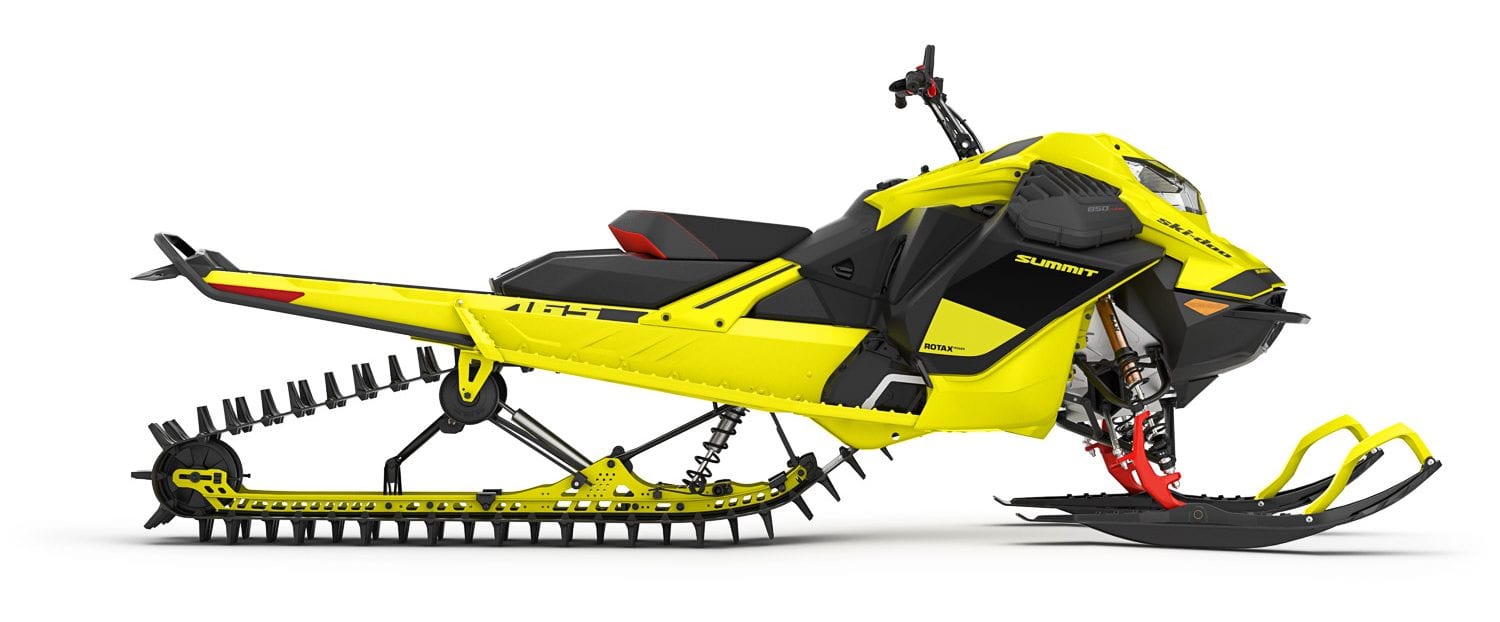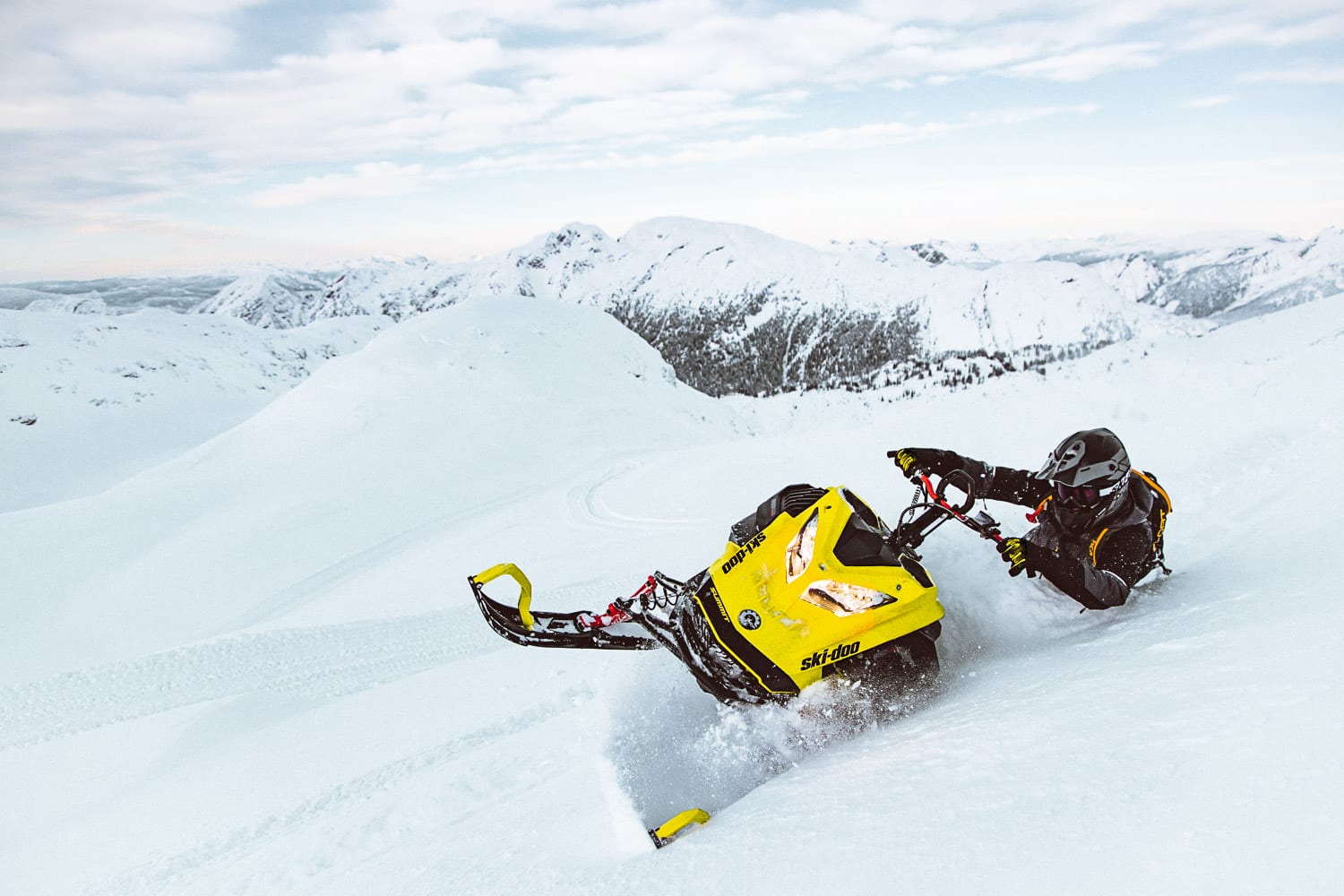The beauty of our world is the surprise effect. Even though we try year after year to predict where the manufacturers are headed, they always manage to surprise us… And honestly, this latest news, a turbocharged two-stroke engine, nobody saw it coming…
Ski-Doo has pulled off a master stroke with this new product, although this is less of an issue for us in Quebec, it is nonetheless a very important technological advancement for the world of mountain snowmobiling.
850 ETEC Turbo engine
Yes, Ski-Doo is the very first manufacturer to offer us a two-stroke turbocharged engine! This engine is very similar to the naturally-aspirated 850 and offers exactly the same power at sea level, i.e. 165 horsepower. But what is the purpose of the turbo? Simply to keep all this power even at altitude… This allows the manufacturer to offer a reliable product, more efficient at altitude and guaranteed! And you can easily imagine that this new concept makes life much easier for the engineers when it comes to calibrating the clutch pulleys. Imagine producing a calibration that will perform well at 125 HP as well as at 165 HP! Well, with this new technology, no more problems, we calibrate for 165 HP always! Bravo!!!

Altitude 101
A naturally aspirated engine, such as the 850 ETEC for example, has a certain capacity to absorb a volume of air depending on its revolution. As the piston moves up, it creates a negative pressure in the base of the engine, which forces air from the outside in through the reed valves. Since the valves are one-way, when the piston goes down, the air cannot go back out where it came in, so it goes up to the top of the piston through the transfer gates. Then the air compresses with the gasoline, the spark and explosion occurs, which brings the piston back down and so on. And this is the key phrase to understand for the rest. So no matter the altitude, your engine ingests the same volume of air according to its revolution.
The higher you go, the less dense the air is, the fewer air molecules there are for the same volume. Your system therefore injects less fuel to maintain an adequate explosion, which significantly reduces power. The Ski-Doo people mention a loss of about 24% at 8,000 feet, which means that the atmospheric 850 ETEC develops approximately only 125 HP at this altitude. And this is the case for all naturally-aspirated engines. The effect of a turbo is quite simple, it compresses the air before the engine draws it in. So by compressing the air, we can find the same number of molecules per volume and even more. In this case, the engineers have configured the intake pressure to work between 0 and 8,000 feet. So at sea level, the turbo injects no pressurized air into the engine, giving it the same power as the atmospheric 850. As you begin to climb in altitude, the system senses a decrease in atmospheric pressure and gradually increases the pressure to its maximum of 4 pounds of pressure at 8000 feet.

When you ride in the Chic-Choc region of the Gaspé Peninsula, the elevation is about 3000 feet. The sudden loss of power is around 9%, which puts your ETEC 850 at around 150 horsepower, 15 less than at sea level. The Etec Turbo version of the 850 makes up for the shortfall by adding 15 more horsepower. It remains at its full power, 165 HP. The phenomenon becomes more pronounced the higher you go. At 8,000 feet, the loss of power approaches 25%, which represents 124-125 horsepower, while the Turbo version will continue to provide its maximum power of 165.
The turbo reaches its maximum efficiency at 4 pounds of pressure (boost), which allows it to maintain its full power until about 8000 feet. After this altitude, power begins to decrease at a rate of approximately 10 horsepower per 2,000 feet. So at 10,000 feet, the 850 Turbo will make about 155 HP instead of 115 for the naturally aspirated model.

To ensure constant turbo pressure, Ski-Doo uses a Blow Off Valve. This valve is electronically controlled and allows to maintain a constant pressure up to a maximum of 4 pounds.
The idea behind this is to offer a guaranteed product that remains reliable at all times. The engineers therefore focused their development on conserving power so as not to overexploit the engine. A difference of 40 horsepower at 8,000 feet is quite considerable, and this by increasing it by only a few pounds…
To compensate for the additional weight, engineers introduced an ultra-light, one-piece hood that places the new 850 ETEC turbo just 10 pounds above its naturally aspirated compatriot.

There is no doubt that Ski-Doo is taking us into another technological era with the arrival of this new engine. Although the use of turbochargers is commonplace in the 4-stroke and automotive worlds, never before has a manufacturer developed the concept for the 2-stroke world. Although there are several aftermarket companies that produce them, they are not subject to the rigors of the industry in terms of reliability, and especially in terms of warranty. In this case, the company offers its 850 Etec Turbo with a full manufacturer’s warranty.
We will have the opportunity to try this new car during the Snow Shoot at the end of February 2020. The high altitude conditions in Montana will allow us to evaluate and see the benefits of this new technology!
We can be proud of our Quebec manufacturer!
For more information on the new, please visit www.ski-doo.com





